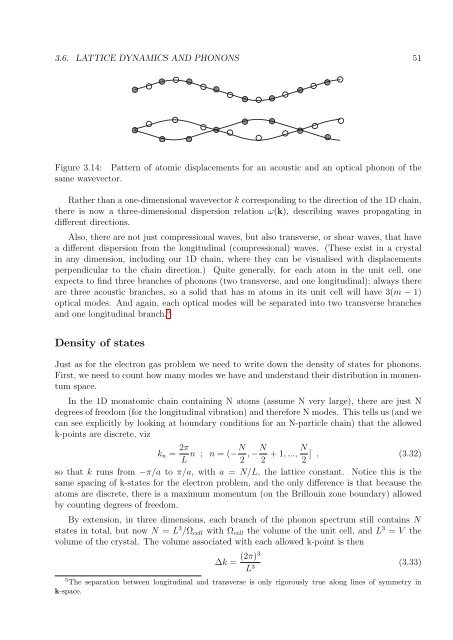Set of supplementary notes.
Set of supplementary notes.
Set of supplementary notes.
You also want an ePaper? Increase the reach of your titles
YUMPU automatically turns print PDFs into web optimized ePapers that Google loves.
3.6. LATTICE DYNAMICS AND PHONONS 51<br />
Figure 3.14: Pattern <strong>of</strong> atomic displacements for an acoustic and an optical phonon <strong>of</strong> the<br />
same wavevector.<br />
Rather than a one-dimensional wavevector k corresponding to the direction <strong>of</strong> the 1D chain,<br />
there is now a three-dimensional dispersion relation ω(k), describing waves propagating in<br />
different directions.<br />
Also, there are not just compressional waves, but also transverse, or shear waves, that have<br />
a different dispersion from the longitudinal (compressional) waves. (These exist in a crystal<br />
in any dimension, including our 1D chain, where they can be visualised with displacements<br />
perpendicular to the chain direction.) Quite generally, for each atom in the unit cell, one<br />
expects to find three branches <strong>of</strong> phonons (two transverse, and one longitudinal); always there<br />
are three acoustic branches, so a solid that has m atoms in its unit cell will have 3(m − 1)<br />
optical modes. And again, each optical modes will be separated into two transverse branches<br />
and one longitudinal branch. 5<br />
Density <strong>of</strong> states<br />
Just as for the electron gas problem we need to write down the density <strong>of</strong> states for phonons.<br />
First, we need to count how many modes we have and understand their distribution in momentum<br />
space.<br />
In the 1D monatomic chain containing N atoms (assume N very large), there are just N<br />
degrees <strong>of</strong> freedom (for the longitudinal vibration) and therefore N modes. This tells us (and we<br />
can see explicitly by looking at boundary conditions for an N-particle chain) that the allowed<br />
k-points are discrete, viz<br />
k n = 2π L n ; n = (−N 2 , −N 2 + 1, ..., N 2 ] , (3.32)<br />
so that k runs from −π/a to π/a, with a = N/L, the lattice constant. Notice this is the<br />
same spacing <strong>of</strong> k-states for the electron problem, and the only difference is that because the<br />
atoms are discrete, there is a maximum momentum (on the Brillouin zone boundary) allowed<br />
by counting degrees <strong>of</strong> freedom.<br />
By extension, in three dimensions, each branch <strong>of</strong> the phonon spectrum still contains N<br />
states in total, but now N = L 3 /Ω cell with Ω cell the volume <strong>of</strong> the unit cell, and L 3 = V the<br />
volume <strong>of</strong> the crystal. The volume associated with each allowed k-point is then<br />
∆k = (2π)3<br />
L 3 (3.33)<br />
5 The separation between longitudinal and transverse is only rigorously true along lines <strong>of</strong> symmetry in<br />
k-space.








